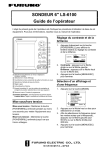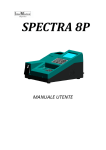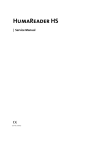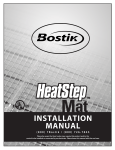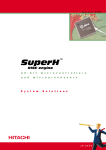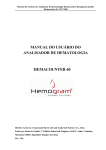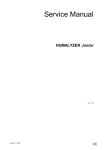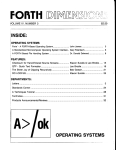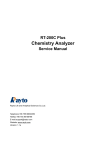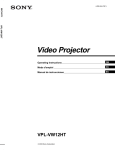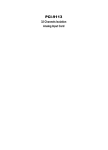Download Maintenance and Repair Manual
Transcript
Maintenance and Repair Manual Copyright: RevA.1 1 Rayto L.L.C. Rayto Electronics Inc. Table of Contents CHAPTER 1: INSTRUMENT OVERVIEW ...................................4 1.1 INSTALLATION ................................................. 4 1.1.1 Unpacking of the instrument ........................................................................................4 1.1.2 Select proper mounting location. ................................................................................5 1.1.3 Power source requirement ............................................................................................5 1.1.4 Connect the instrument to the power source .............................................................5 1.1.5 Connect to the external printer. ...................................................................................6 1.1.6 Adjust the display to a appropriate position .............................................................6 1.1.7 Place flowcell. .................................................................................................................6 1.2 STRUCTURE ..................................................... 8 1.2.1 Front view ........................................................................................................................8 1.2.2 Key Board .........................................................................................................................9 1.2.3 Back view........................................................................................................................10 1.2.Flowcell..............................................................................................................................10 1.3 INSTRUMENT PARAMETER .......................................... 12 CHAPTER 2 FUNCTION DESCRIPTION............................. 13 2.1 RT-1904C FUNCTION FRAME...................................... 13 2.2 DESCRIPTION OF POWER SOURCE FUNCTION ............................ 13 2.3 MAIN BOARD FUNCTION DESCRIPTION ................................ 13 2.3.1Main board function illustration ................................................................................13 2.3.2Main board function diagram .....................................................................................14 2.3.3 Main board principle description. ............................................................................14 2.4 FRONT BOARD FUNCTION DESCRIPTION ............................... 15 2.4.1 Front board function illustration ...............................................................................15 2.4.2 Front board principle frame .......................................................................................16 2.4.3 Light filter selection and control ...............................................................................16 2.4.4 Liquid absorbing control of pump..............................................................................16 2.4.5 Temperature test and control ......................................................................................17 2.4.6 Light energy sampling and conversion ....................................................................17 2.4.7 Halogen tungsten lamp control..................................................................................17 2.5 PIPELINE FUNCTION DESCRIPTION.................................. 18 2 2.5.1Function illustration .....................................................................................................18 2.5.2 Pipeline structure..........................................................................................................18 2.6 LIGHT PATH FUNCTION DESCRIPTION ............................... 18 2.6.1 Function illustration ....................................................................................................18 2.6.2 Light path structure ......................................................................................................19 CHAPTER 3 FITTINGS REPLACEMENT ............................ 20 3.1 INSTRUMENT DISMANTLING METHOD.................................. 20 3.2 LAMP REPLACEMENT .............................................. 22 3.3 POWER SWITCH REPLACEMENT ...................................... 23 3.4 LIGHT FILTER REPLACEMENT ...................................... 24 3.5 CHANGE SIGNAL RECEIVER ........................................ 26 3.6 PIPELINE CHANGE ............................................... 28 CHAPTER 4 DAILY MAINTENANCE .................................. 31 4.1 GENERAL INTRODUCTION .......................................... 31 4.2 CLEAN INSTRUMENT .............................................. 31 4.2.1 Clean outer surface of instrument.............................................................................31 4.2.2 Clean flowcell ................................................................................................................31 CHAPTER 5 COMMON MALFUNCTION LIST ................... 33 3 Chapter 1: Instrument Overview RT-1904C is an internet-oriented chemistry analyzer, it can be used in the measurement of the following matters: Electrolytes Substrates Enzymes Plasma proteins Hormones TDA‘S It can program 160 test items. All the original program setting of tested items can be revised by user. It has double coloring system: One is flowcell system and the other is cuvette system. Following test methods can be provided: Endpoint Two point Kinetics Bichromatic Absorbency Multi- Calibration It can analyze samples of blood serum, blood plasma, whole blood and urine etc. It can connect to the internal network of hospital, quality supervision center and Rayto user service center, and bring great convenience to the work. Either built-in printer or external printer can be selected. The external standard key board, CRT display, mouse and bar code scanners can be choose to equip. 1.1 Installation 1.1.1 Unpacking of the instrument Unpack the instrument and remove the materials used for delivery. Keep the packing boxes and materials for repacking the instrument in the future. 1) Take the instrument out from the boxes. 2) Take away the packing materials, take out the instrument from the plastic packing bags. 3) Check the articles in the packing box and confirm that the following articles are contained:: RT-1904C mainframe User’s manual 4 Packing list Repair guarantee certificate of the agent Power source line 1.1.2 Select proper mounting location. The instrument should not be directly exposed to the sun.. The working table selected shall be smooth in surface and has enough space to mount RT-1904C. The front edge of instrument shall be close to the edge of working table. The working table is prevented to have great vibration(e.g. centrifuge is placed on the table). Note: The working environment of the instrument: The temperature shall be 15℃-32℃ The related humidity shall be20%-85%。 To ensure the normal operation of the instrument, it is forbidden to mount the instrument in the following places: A place with extreme change of temperatures. A place too hot or too cold A place with many dust Close to electromagnetic equipment that can produce magnetic field. 1.1.3 Power source requirement AC110V ~AC250V 50~60 Hz 80W 1.1.4 Connect the instrument to the power source 1) Insert one end of power source line to the power source socket of the instrument. 2) Insert the other end of power source line to the alternating current power source socket. Warning 5 ● The alternating current shall have fine grounding ( zero voltage<5V)。 ● The alternating current shall be stable. It is forbidden to use power source together with appliance with great voltage. It is better to equip stable-voltage power source. ● If smoke, peculiar smell, or strange sound is found in the instrument , turn off the power immediately and contact with repair service center. ●When pulling out power source line, hold the connector plugs , do not hold power source line. 1.1.5 Connect to the external printer. 1) 2) 3) 4) 5) Confirm the printer and instrument are closed. Insert the printing cable to the output port at back of the printer. Fix the plug with the wire button that is used for fixup. Insert the other end of printing cable into the RS-232 port of the instrument. Connect the printer with alternating current power source with power source line equipped in printer. Note: RT-1904C can also use special built-in heat sensitive printer. 1.1.6 Adjust the display to a appropriate position As indicated in the following drawing, move the LCD display screen to an appropriate position deemed by you.(beware to impose proper strength). Diagram 1-1 Adjust display screen 1.1.7 Place flowcell. As indicated in the following drawing, take away the cover of flowcell (beware proper 6 strength is used) Diagram 1-2 Open the cover of flowcell 1) Tear the adhesive tape use in fixing flowcell. 2) Remove packing materials 3) Place the flowcell into incubation carefully and make the aspirate tube in front。 Warning: Do not touch the surface of transmit window of flowcell to avoid befouling of the transmit window with grease of hand and effect the absorbency. 7 1.2 Structure 1.2.1 Front view ① ⑤ ② ③ ④ ⑨ ⑥ ⑦ ⑧ ⑩ Diagram 1-3 Front view ①Lamp cover The cover can be opened to replace lamp and perform pump maintenance. ②Flowcell Cover Open this cover, cuvette can be used to do sample test. ③Aspirate tube absorb the sample into the flowcell. ④Aspirate key Push the key at test state, the instrument can automatically absorb the samples into the flowcell. ⑤LCD display Display colorful words or diagrams. ⑥Keyboard Some common hot key. The printing and cleaning etc can be performed only by one press of the key by operator. ⑦Right and left key It is used together with mouse. Please refer to the “operation of mouse”221 RT-1904C Biochemistry Analyzer User’s Book ⑧Mouse It can be used with mouse. Please refer to the “operation of mouse”221 RT-1904Biochemistry Analyzer User’s Book ⑨LED lamp When the instrument is powered, the LED lamp is on. ⑩printer cover Open the cover, the built-in printing paper can be placed. 8 1.2.2 Key Board Diagram 1-4 Key Board 1) key of soft key board: *Push the key to open the soft key board. Push this key again to close the soft key board.. 2) Rinse key: 3) Print key: * start or stop cleaning flowcell of the instrument *Push this key to start printing immediately (it is intended for built-in printer and invalid for external printer). 。 4) a Paper feeding key: *Push the key to feed paper into the printer (it is intended for built-in printer and invalid for external printer). 5) lamp switch key : *Switch on or off the lamp. Left key: *In 7) Right key: *Push the key to move rightward. 8) Confirm key: 6) the display menu, push the key to move leftward. key. 9 *At sample test, its function is equal to aspirate 1.2.3 Back view 图 1-5 ① Power switch: ② Fuse: ③ ④ ⑤ ⑥ ⑦ AC INPUT: Fan: Printer port: Mouse port: RS-232 port: Back view To switch on or off the power source of the analyzer Check fuse of instrument if there is no power supply after switch on the power switch. Power source line socket. It is used in the cooling of instrument. It is used to connect external printer. It is used to connect external mouse. Communicate with PC. ⑧ CRT port: It is used for connecting the external CRT display. ⑨ Ke y_ B Stan dard ke yboa rd port: It is used in the external standard keyboard. If PS/2 port mouse is used, a patch cord is needed to equip. ⑩ Telephone line port: Connect telephone line for remote networking ⑩ DRAIN PORT: waste out here. 1.2.Flowcell Open the cover of flowcell as indicated in the following drawing. Note: When opening the cover of flowcell or inner cover of light lamp, press the two sides of cover so that it deform innerward ,and then open it according to the direction of the following drawing. 10 Diagram 1-6 Opening the cover of flowcell Inside the colorimetry system there are: Incubation Colorimetry bracket Inner cover of light source Flowcell Inner cover of light source incubation Flowcell bracket Diagram 1-7 Inside of colorimetry system 11 1.3 Instrument parameter Linearity range 0.000-2.500A Resolution 0.001Abs(display),0.0001 Abs(inner calculation) Light source halogen tungsten lamp,6V/10W,service life about 1000 hours Wavelength 340,405,500,546,578,620,670nm ,One blank for optional filter excursion 0.003A/30min semi-bandwidth <10nm Temperature control Room temperature,25,30,37℃ (Peltier component),precision±0.1℃ Flowcell 30μl quartz flowcell Sample volume feeding 200-3000μl (add 50μl) Cuvette 12.5mm×12.5mm square test tube Cross pollution ≤1%(500μl) Storage 160test items,500 test results Port Mouse,RS232,CRT,RSTN,Keyboard,Printer Display 7″color LCD display(640×240line),256color Print Built in or external universal printer Computer Embedded high speed processor Working environment 15℃-32℃;Maximum humidity85%R.H.(below30℃) Storage environment -20℃-50℃; maximum 85%R.H.(below 30℃) Weight 10kg Dimension 450mm(L)×330mm(W)×140mm(H) Fuse 250V, 3.15A Power supply 110VAC-250VAC±10%,50-60Hz 12 ,≤1.5%(300μl) Chapter 2 Function Description 2.1 RT-1904C function frame Refer to the following. 2.2 Description of power source function The power used by the RT-1904C machine is provided by electric source module. The high frequency PWM conversion technology is adopted so that the electric power has the advantage of small size, light weight, high efficiency, high reliability, high load adjustment ratio and power adjustment ratio etc. Two stage conversion is adopted in the power structure. One stage is single reverse current AC/DC conversion , the other is DC/DC Buck converter, so that the direct power exported from 4 passages had high voltage precision and adjustment rate. The power source module exports 4 direct current , the power usage situation is as the following: It is used in light filter generator , pump generator, Peltier temperature CH1: +12V/3.3A rise/fall and fan generator. +5V/2.6A It is used in the main board and front board logic control CH2: It is used in tungsten halogen lamp CH3: +5V/2A It is used in embedded printer. CH4: +5V/3A Ch5: +6V/0.8A It is used in peltier temperature rise/fall. 2.3 Main board Function Description 2.3.1Main board function illustration 1. It acts as system platform and provide operating environment for system software and application software. 2. It provides connection port with front end system, perform the control of front end system and data collection and processing; It provides I/O port of the system. Component that supports the I/O ports are as the follows: four RS232 port that used respectively in the embedded serial port mouse, embedded serial printer, embedded modem and outer RS232 port.1 parallel printer port ; one key board panel port; one external XT compatible key board port; one embedded speaker port; one simulation telephone line port; one 640×480 CRT display port, one 640×240 LCD display port. 13 2.3.2Main board function diagram Frame Memory Local BUS CRT Interface KeyPad Interface SH7709 HD64461 RS232 PORT TTL level 232 port FLASH MEMORY & DRAM TL16C552 Socket Modem EPLD control logic Amplifier Parallel printer interface Inside Mouse interface Inside serial port printer interface XT compatible keyboard Interface LED Display Speak Interface Phone Interface Diagram 2-1 Main board function diagram 2.3.3 Main board principle description. As indicated in the above diagram, the main board is consists of the following major part: 1. SH7709、Flash Memory and DRAM constitute the basic platform of system operation; the system software and application software is fixed in the Flash Memory. The address space of Flash Memory is distributed in the 0 district of system storage area. The address space of DRAM is distributed in the lower 32M space of 3 district of system storage area. The outer frequency of CPU is 20MHz. When the system starts, the program is directly executed on Flash Memory; the start area program on Flash Memory can complete upgrading of software. 2. HD64461、Frame Memory constitute the outer controller of the system, that mainly used in support CRT and LCD display. The address space of Frame Memory is distributed in the high 32M 3 district of system storage area, and connects directly with HD64461. HD64461 supports the port with SH7709, color/single color STN-LCD port, CRT(VESA VGA)port and UART that is compatible with standard 16550. In the system the display port of HD64461 is connected with LCD or CRT display , through UART it constitute one serial port of TTL electric level and connected with serial port of Socket Modem so as to provide remote maintenance ability for the system. 3. Serial communication port and parallel ports There is 4 serial communication ports and one parallel port on main board: the serial port 2 on SH7709 constitute RS232 for outer use; the PB port on HD64461 constitute TTL electric level 14 serial ports to connect with modem; through the expansion of TL16C55 chip, another two serial ports and one parallel ports is provided by the system; one serial port is used in connecting embedded mouse, the other serial port is used in connecting of embedded printer; the expanded parallel port is used in connecting external parallel printer. 4. The transmission rate of Socket Modem module data is14.4K bits, it support At command bank, connect with TTL serial port on HD64461, it connected outer simulation telephone line for use in support the remote diagnosis, maintenance and upgrading of the system. 5. Programmable logic equipment The programmable logic part can complete logic control of various part of the system. Through the equipment the XT compatible key board port and the LED indicator light port are expanded, it provided transmission control of disconnected signal and control of local bus that connected on the front end. And it produces the M signal for use in the STN-LCD display screen. 6. Key board scanning and voice signal amplifying Key board scanning logic is constituted by low 4 area ofSH7709 PTC port, and low 4 area of PTF ports to form a 4×4 key board scanning. SH7709 regularly give out from PTC ports the signal to scan keyboard. The PTF port inspects the key push action, it is delivered by LM386 and amplify and export the voice signal given out by SH7709 and Socket Modem to speaker port. 7. Power conversion circuit The system power provides +5V power for main board. The main board need mixed power supply of +5V and +3.3V. Therefore +5V to +3.3V power conversion of main board is needed. 2.4 Front board Function Description 2.4.1 Front board function illustration The front board is under the control of main board of computer. The plate execute and complete all the unique functions of the semi-automatic biochemical analyzer, it is the control execution center of the semi-automatic biochemical analyzer. In the RT-1904C product of semi-automatic biochemical analyze, the front board mainly complete the following functions: Selection of light filter pump rotation to absorb certain amount of liquid Control of tungsten halogen lamp(switch on/off) Transfer, amplify and sampling of light and electric signals Temperature test and control 15 2.4.2 Front board principle frame The front board principle frame is as follows: 1904C semi-automatic bio-chemical analyzer front end plate principle frame Location Detection Filter circuit logic control Logic control Bus connected with back end plate logic control Filter step motor Drive circuit Peristaltic pump motor Peristaltic pump Step motor Peltier temperature control Peltier Temperature test Halogen tungsten Halogen tungsten lamp logic control Lamp A/D conversion Photoelectric receiving and conversion circuit Fig 2-2 Front board function diagram 2.4.3 Light filter selection and control In the semi-automatic biochemical analyzer RT-1904C product,the categories of selected light filter is as follows: 340nm﹑405nm﹑500nm﹑546nm、578nm、620nm、670nm totaled 7 kinds. Different wavelength of light filter is needed for different test method. Place the entire filters evenly on circumference of 8 hole round disk. The angle of neighboring two hole is 360/8=45°. The remaining hole is preserved for adding unique wavelength filter in the future. The round disk is rotated by step motor. When step motor rotates on different angles, different wavelength filters is selected by the system. The model of step motor is UBD6N07D04AKNC. The reduction gear is equipped in the motor to increase the rotation moment. The reduction gear is equipped together with step motor 8254 OUT. After exporting filter and pulse, related filter is selected. 2.4.4 Liquid absorbing control of pump In the semi-automatic biochemical analyzer RT-1904C,the instrument automatically absorbs related amount of reagent according to the amount of liquid set by the test item. Similar with the filter, the step motor is adopted to control precision amount of liquid absorbing. The control method is similar to that of the filter step motor. When the step motor rotates different angel, the instrument absorbs different amount of reagent. Since the moment is large when pump is absorbing and rotating, the double stages step motor is selected. The model is 17HS1022. The double stage drive of L297 and L298 control/drive chip are adopted in related circuit drive. 16 Since the test sample is different and have different density, it can offer different absorbing rate to users. 1~8 rates are set on pump. Different frequency division is written on Timer/Count of 82C54. OUT0 exports different frequency, the pump rotates in different rates. 2.4.5 Temperature test and control Temperature control can be divided into temperature test and temperature rise/fall. The bus all digital temperature sensors DS1820 produced by DALLAS that can decrease peripheral conversion circuit is adopted in temperature test. 2.4.6 Light energy sampling and conversion The sampling test of light energy is the core of semi-automatic biochemical analyzer. All the test and calculation of semi-automatic biochemical analyzer are performed through test on light intensity. Therefore the light energy sampling shall be precise and stable so that the requirement of instruments on sampling test speed can be satisfied. The photoelectric sensor OPT301M of B-B Company is adopted. The component integrates the silicon photovoltaic cell and embedded calculation amplifier. The silicon photovoltaic cell transfers the photocurrent signal into low voltage signal. The embedded calculation amplifier amplifies the low voltage so as to satisfy the measurement requirement of voltage. OPT301M has the strong point of high integration and fine performance. at the same time only by transferring the voltage signal into digital amount to CPU can it start processing. So A/D transfer circuit shall be added. ADS774 of B-B company is adopted as A/D converter, its main indexes are: 12Bit. All can satisfy requirements of instrument on measuring range, precision and speed. The voltage range of input A/D is 0-10V. 2.4.7 Halogen tungsten lamp control To lengthen the service life of the lamp, the instrument shall automatically shut the lamp if instrument does not measure after being on for a long time. The lamp used by the instrument is halogen tungsten lamp. Its specification is 6V/10W. Both the current passes and voltage are high .If voltage MOS tube is adopted to control on/off of halogen tungsten lamp, voltage drop of the voltage MOS tube is great, the voltage consumption is also great, many disadvantages such as heat emission will be brought along. So the small relay is adopted to control. The voltage drop of relay contact is almost zero. And the voltage of relay line package is small. Control signal is put out by PB.6 of 8255. Audion is used to drive on/off of line package that control relay. 17 2.5 Pipeline Function Description 2.5.1Function illustration In instrument measurement, aspirate key is pushed, system control drive the rotation of pump generator. The pinch wheel of pump presses the pipeline and enable the tested liquid in pipeline extrude to liquid drainage port. The tested liquid is absorbed into the flowcell. When sample volume set by measuring item is absorbed, the system control stops the pump generator. Liquid to be tested is in the flowcell for measurement. After measurement, the system control drive the rotation of pump generator, emptying the tested liquid in flowcell to decrease cross pollution and ready for the next measurement. 2.5.2 Pipeline structure Diagram 2-3 Pipeline Structure 2.6 Light Path Function Description 2.6.1 Function illustration The optical structure of RT-1904C is, as the above diagram, spectrums structure after going through light filter. After lightening tungsten halogen lamp, radiate light with filament as center is given out. The radiate light is converted to parallel ray after going through convex. The protection glass plays the role of protecting convex. After the parallel ray shoots the flowcell with sample liquid to be tested, a part of light energy is absorbed by liquid. Light that shoot up is called shoot-up light. The shoot-up light is changed to single color light after going through single color filter. The single color ray shoots on the photoelectric receiver. The photoelectric receiver transfer the light signal into electric signal and input it to front board for processing. The color of filter and color of tested liquid shall be additive complementary colors. 18 2.6.2 Light path structure Diagram 2-4 Light path sketch map ①.lamp ②.Protection glass ③.Convex ④.flowcell ⑤.filter ⑥.signal receiving assembly 19 Chapter 3 Fittings Replacement 3.1 Instrument Dismantling Method RT-1904C is a high precision and complicated instrument. There is no component inside that can be repaired by users. In case the instrument fails and cannot be solved on above method, specialists will be sent for to repair. When it is determined that inner parts of instrument has broken down and repair is needed, please dismantle the instrument according to the following procedures: 1)Thoroughly drain out the remaining liquids in pipeline of the instrument, fix the flowcell. 2)Turn off the power switches of instrument and printer respectively, pull out electric source line. 3)Dismantle printer cable with screwdriver. Pull out external mouse, connection line of modem, and other cables connected to the Screws (7) analyzer. Diagram 3-1 The location of screw used for connecting upper and lower covers. 4)Place silk on a clean and smooth table, reverse the instrument on the silk to prevent damage to outer surface of plastic cover of the instrument.。 5)Use screwdriver to unscrew seven screws used in connecting metal base and plastic upper cover according to the above diagram. 6)Carefully place the instrument on the table, open the light source cover, take out the aspirate tube from the fix hole on upper plastic cover, dismantle the flowcell also, and place them in a safe place. 7)Dismantle first the embedded printer cover, flowcell cover, pump cover. Hold the front side of upper plastic cover with both hands; carefully lift the upper plastic cover. Notice 20 that the upper and lower covers are connected with many groups of cable. Prevent excessive force that damages plug and sockets for cable connection. If separation of upper and lower covers is needed, the connection cable shall be pulled out from the socket. The sketch map after separation of upper and lower covers is as the following: Diagram 2-2 Sketch map after the upper and lower covers is separated. 21 3.2 Lamp Replacement ④ The structure of light source lamp is as the drawing: ② ① ③ ①.fix screw. Its function is to fix the lamp on light path.. ②、③.adjustment screws. Its function is to micro adjust the location of lamp in order to adjust the intensity of light.。 ④.power source line for lamp. It can supply power for the lamp. 1. Turn off the machine, open the inner cover, pull out power source line of lamp, unscrew the bolt①,take out the light source lamp. 2. Place a new lamp on the light source seat, screw the bolt①,but do not screw it too firm, connect the lamp power source line. 3. Screw the bolts ②、③ ,but do not screw it too firm 4. Open the machine and enter the main menu, select“ABS”option; after entry, set wavelength as 340nm and num of point as240,absorb distilled water to test. 22 5. Move frontwards and backwards the location of the lamp to maximize the tested AD value.(value in the small bracket.e.g.3000) 6. Adjust bolts②、③,notice that the movement of ②、③ will lead to reverse effect to the AD value. Find out the right bolt which enable the tested AD value to about 3000(1600—3000 also permissible ) ,and then fasten it. 7. Fasten bolt①,and place the cover of the lamp. 3.3 Power Switch Replacement 1. Turn off the machine, unscrew the bolts on base of instrument; take out the upper cover of instrument. 2. Pull out plugs①、②、③(diagram -1)。 3. Press firmly the flip plate④ on both end of switch, push outwards the entire switch seat and remove the switch seat(diagram-1) 4. Pull out tie-in of power source line⑤、⑥ with switch. Press firmly the flip plate and push outwards the switch.(diagram-1) 。 5. Take a fine quality switch,the Ⅰon the switch faces the power source line socket, press in the switch. 6. Connect the tie-in of power source line⑤、⑥and switch.(diagram-1)。 7. Press the switch socket outwards into the base of instrument(diagrram-2),the power source line socket shall face the fan.(diagram-2)。 8. Connected power source line①、②、③(diagram-1) 。 9. Place the upper cover, firmly screw bolts. Open the machine (note that various connection line do not press on the bolt port to prevent damage of connection line.)。 23 Diagram-1 ③ ⑤ ⑥ ⑤ ① ⑥ Diagram-2 ② ④ Power source line socket fan 3.4 Light Filter Replacement 1、 Open the upper cover of RT-1904C,beware of the connection lines between upper cover and main board. 2、 Unscrew the fix bolt of light filter cassette . Filter cassette Fix screw 24 3、 As indicated in the drawing, draw out anti dazzling screen, at the same time unscrew3 screws on the filter wheel.. anti dazzling screen 3 screws 4、Unscrew the fix screw and dismantle the step motor. 5、First draw out step motor and take out filter wheel as indicated in the drawing. Unscrew the fix screw 25 6 The taken out filter wheel is as the drawings: 670nm 546nm 340nm fix copper ring Gap 7、 Filter with various wavelengths is show in the drawing. The gap related wavelength is 340nm,the wavelength 340nm~670n mare arranged clockwise. 8、 Carefully take out fixing copper ring, take out used light filter. Take out copper ring Take out used filter 9、Replace new filter with related wavelength, fix it with cooper ring. And the replacement is completed. 10、Reverse the above dismantling procedure, then the filter can be place in the anti dazzling screen cassette . 3.5 Change Signal Receiver The function of signal receiver is to change the varying light signal into the electric signal and then calculated and process. It is the most important component in the light path system .The change method is as follows. 26 1、After remove upper cover of RT-1904C,the signal receiving cassette can be seen (left side the step motor). Casstte 2、Unscrew screws, remove the cassette, the signal receiver plate can be seen. White mat signal receiver plate screw with red mat 3、Unscrew 3 screws with red mat, draw outwards the receiver plate and the whole assembly can be seen. Signal receiving end Power source line 4、Replace new signal receiving assembly, connects power source line, screw the screws, add mat and equip with cassette. Thus the replacement is finished. 5、Connect the other end of power source line in the 4pin and 2pin plugs of front board. The signal receiver can work normally. 4pin plug 27 3.6 Pipeline Change 1、Change of aspirate tube. Hold the coarse side of flowcell. Carefully pull out the aspirate tube from the sample feeding port of flowcell. And replace it with a new one.(Refer to diagram-1) diagram-1 aspirate tube 2、Change of transfer tube: Hold the coarse surface of flowcell, pull out the transfer tube from the liquid draining port, pull out another end on the pump, and equip with new transfer tube.(refer to drawing-2) Drawing-2 Transfer tube aspirate tube Note:carefully perform the above operations, do not let water drop on main board.. 28 3、Pump replacement: The whole view of pump is as following: Clip button Adjustment screw Clip bar Pump body Pump tube Generator Copper column The copper column is used to fix the pump on the RT-1904Cbase. 1、 Unscrew the adjustment screw and break off the clip button and clip bar. Clip bar 2、 Open clip button, the pump tube can be seen. Clip button Pump tube 29 3、 Take out the pump tube, tear the belt, then the pump tube can be removed from the white cuff. belt White cuff 4、 Replace a new pump tube, tie the belt, operate reservedly so that the replacement can be completed. At last adjustment firmness with adjustment screw. 30 Chapter 4 Daily Maintenance 4.1 General Introduction RT-1904C is a clinic precision analyzer. To keep the instrument in a fine state, daily maintenance shall be performed. The maintenance of RT-1904C is very simple, but it shall be done earnestly and carefully. 4.2 Clean instrument 4.2.1 Clean outer surface of instrument. ● Keep clean the working environment of instrument. ● Neutral detergent and wet cloth wiping are needed in cleaning the surface of equipment. ● Use soft cloth to clean the liquid crystal display. Warning: Do not let any solvent, grease or eroded matter to contact the instrument. 4.2.2 Clean flowcell The clean of flowcell shall be kept so as to ensure the accuracy and reliability of test results. 1. Outer flowcell clean a、According to the requirement to place flowcell.(refer to1.1.7)。 b、If the outer flowcell is polluted, take a soft cloth soaked with water to clean it softly. 2. Inside flowcell clean a. Put vessel with distilled water under the aspirate tube, push RINSE key to start continuous cleaning function. Push RINSE key again to stop cleaning. Generally the cleaning takes half a minute. b. The detergent of glass vessel or NACLO, (0.1N)、tween 20 diluted liquid (2-3drop/L) are used to clean flowcell. Push RINSEkey to absorb the detergent, again push RINSEkey to stop the rotation of pump. Let the detergent to settle in flowcell for 5 minutes. At last continuous clean it for 1 minute by distilled water. If it cannot be cleaned with once cleaning, detergent can be used to clean for a second time. The flowcell shall be cleaned in the following circumstances.: The water blank difference is too large when open the machine. 31 Transfer test items. Before closing the machine. Warning:Do not let reaction liquid or other pollutant in the flowcell for a long time. 32 Chapter 5 Common Malfunction List Malfunction Settlement time pop up randomly, date can not be stored after change. Battery used out,replace another battery. Check whether the D2、D3 beside battery is damaged, replace it. Water blank value is not stable, it is high and negative value Bubble is liable to be absorbed in the flowcell. The flowcell is dirty ,clean the flowcell with 5%NaClO for several times and clean it with distilled water. Sample feeding tube is break; replace it. Signal receiving assembly is damaged, replace it. Air is absorbed in the first machine opening, switch off the machine and absorbed again the distilled water. Great absorbency differences It is because that air is absorbed, absorb again distilled water. Change for new distilled water There is air in the pipelines, re-connect or change pipeline. The light intensity of lamp is low, change lamp. The flowcell is damaged, change the flowcell , The flowcell has not been insert to the bottom. There are no factors; factor does not been input in the kinetic method. Standard has not been set in end-point method and two points method, or the standard was set but haven’t get the factor in the calibration.. The parameter is not right, re-input is needed. There is bubble or defilement in flowcell. Do it again after cleaning. The light filter is aging, replace light filter Check whether the front board, Signal receiver are damaged,. The aspirate volume is too low, increase the volume . The reaction liquid is polluted. There is dirt in light path, blow with ear absorb ball or dismantle light path to clean(use lens wiping paper) The lamp is in the wrong location, make re –adjustment Check whether the lamp and light filter are aging, change if there is any. No test results The test is not accurate, there is great deviations in results. Low light intensity Blank screen and break down when start the machine 33 The switch fails, change the switch. Power source fails(import to J3 must be 5V,J10 must be 5V、6V、0V,J11must be 12V、5V、0V)replace it. The software is damaged, upgrade the software. Disorder screen Historical data item cannot be entered. Temperature control fails The pump do not rotate, give out noise, and do not absorb liquid. It is reported that “please check whether the filter wheel is in normal operation.” The small drop-out line (old machine) is damaged, replace it. Check chip of main board (7709),FLASH chip,9735chip。 Replace the damaged ones. Check whether the FLASH chip on the main board is damaged, replace it if there is any LCD display line is in poor contact, pull out or re-plug in or use glue. (old machine) Check whether the FLASH ROM chip on mainboard is damage. Change it if there is any. In front board J11,J8plug has poor contact , pull out and replace it. U10 is invalid welding or damaged, re-welding or replace it. The peltier is damaged(it shall be 4 ohm in empty load) change it. The pump value and receiver plate value doesn’t adjusted after upgrading. Re-enter the pump value and receiver plate value Check the 4M crystal vibration on front board is damaged, change it if there is any damage. The sleeve of light sensor of receiver end newly replace is too long, use scissors to shear it . Check if the positioning light coupling is damaged, replace the positioning light coupling. Check whether the L297,L298,5804LB on the front board is damaged or not,change it if there is any. Appear 4095 Newly replaced filter, add attenuation plate or adjust position of lamp. The filter wheel does not rotate in place, use philips driver to fix the filter wheel, check the fix light coupling, adjust position of light coupling or replace it the report can not be printed. Reset related printer in system configuration, pull out plug or replace it. Print cable and change printer. The analyzer can not starts. Check whether the instrument is power on. Check whether the power source plug is loosened. Check the fuse Check the voltage Check whether the power source plug is loosened. Check ON/OFF button Check fuse The printer cannot start. 34 The printer can not print There is no liquid in flowcell. The results has low repeat performance. The absorbing volume of flowcell is not constant. The quality control is not in the range of targeted value. When break line and set standard in end-point method,it is suggested that “standard set error” Temperature control time is too long. Switch on RT-1904 first and then switch on printer. Check whether the connection is in normal state. Check whether the pump is in normal operation. Check the connections of aspirate tube and flowcell port etc. The aspirate tube is too long or too short. The aspirate tube may be blocked and must be clean and unblock it. The flowcell is very dirty. There is bubble in flowcell, and cleaning is needed. Check the liquid absorbing of flowcell. Aspirate tube inserts too deep into the flowcell, pull it out a little. Check whether the aspirate tube is blocked or not The pump tube may need to replace. Check the valid period of the reagent. Check whether the setting is right or not and whether parameter revision is needed Ensure the quality control cannot be polluted. Re-measure with another method. Check the flowcell; use another reagent and re-measure. Check whether standard material is absorbed correctly. Please exit the standard setting procedure and enter, reset the standard. The normal work temperature range is 15℃-32℃ Note:If unsolvable error is found during the operation process or re-appear of certain error, please contact the supplier. Chapter 6 35 Common Fittings List Common Fittings 36 Fitting Number Light filter 340nm 1212 001 0 Light filter 405nm 1212 002 0 Light filter 500nm 1212 003 0 Light filter 546nm 1212 004 0 Light filter 578nm 1212 005 0 Light filter 620nm 1212 006 0 Light filter 670nm 1212 007 0 6V 10W halogen tungsten lamp 1212 009 0 Main board battery 1222 018 0 Signal receiving assembly 2100 003 1 Power upper cover 1211 040 0 Power base 1211 041 0 Power PCBA 2100 006 0 Front board 2100 001 0 Main board 2100 005 0 Key board plate 2100 004 0 Power switch (with socket) 1212 012 0 FLASH Rom 1110 072 0 LCD display 1212 015 0 LCD display cable 1213 003 0 Voltage inverter 1212 013 0 Peltier 1212 019 0 Trough light coupling 1190 004 0 Flowcell(two tube diameters) 1212 010 2 Lamp holder lamp Main board battery Signal receiver Power lower cover Power complete machine Power PCBA plate Power upper cover Front board 37 Main board Flash Rom Power Switch assembly LCD Display cable Main cable Voltage inverter B 38 Trough light coupling Note: This manual may contain other ownership declaration and copyright information. Its articles shall be observed and abided by. The information in the manual may have inaccurate parts in technology and printing error. The manual can be revised or upgraded without additional notice Rayto company also can improve/revise the product/program described in the material at any time without additional notice. 39







































